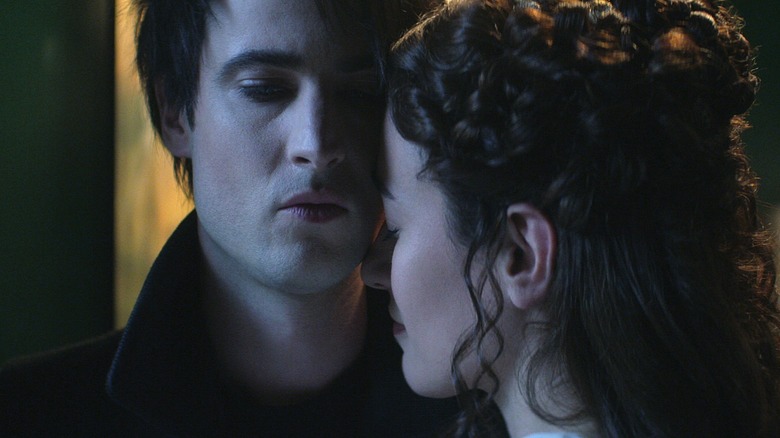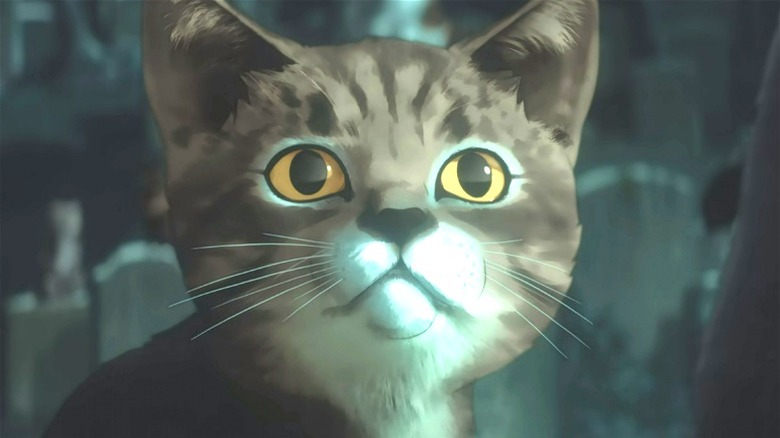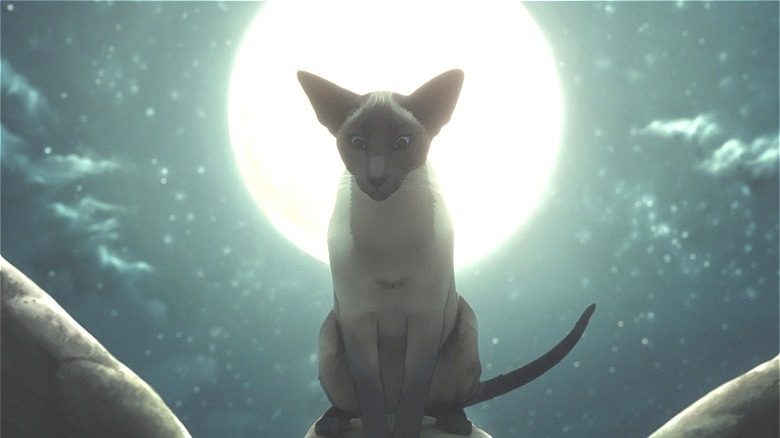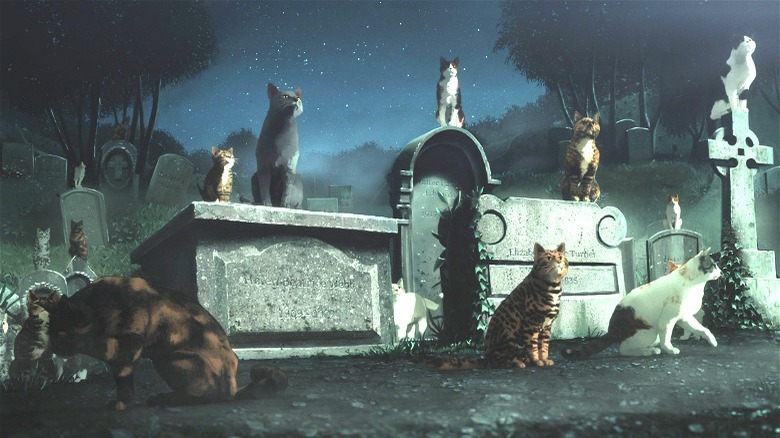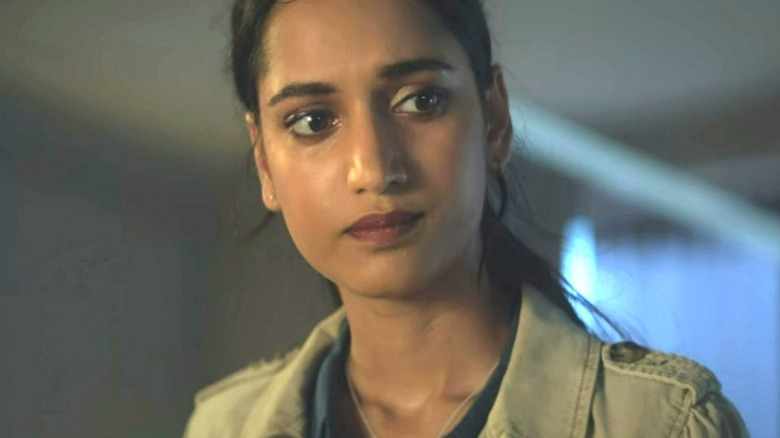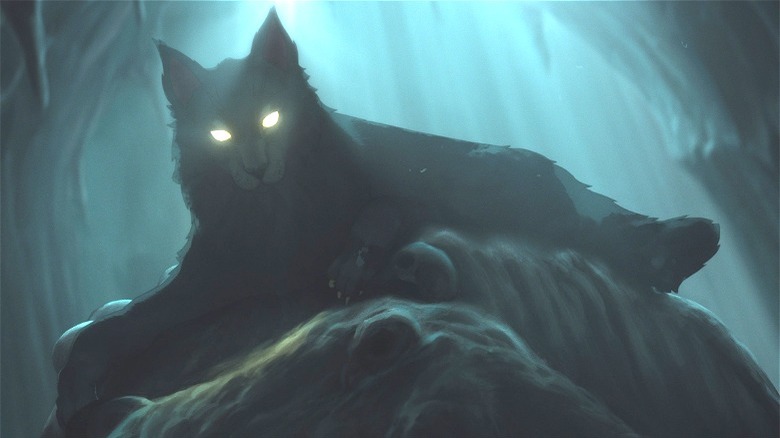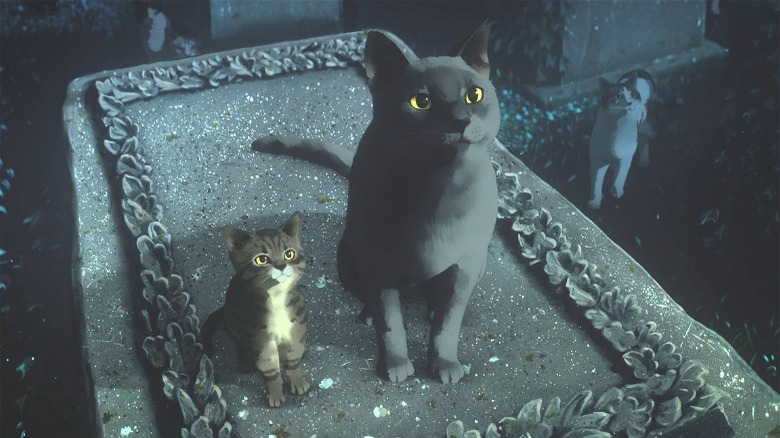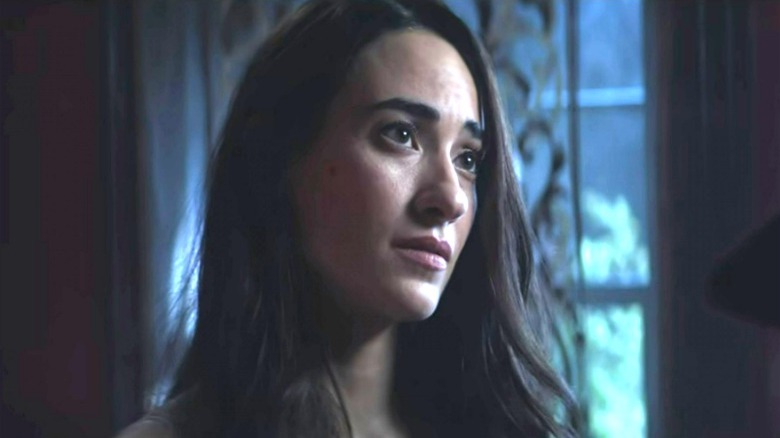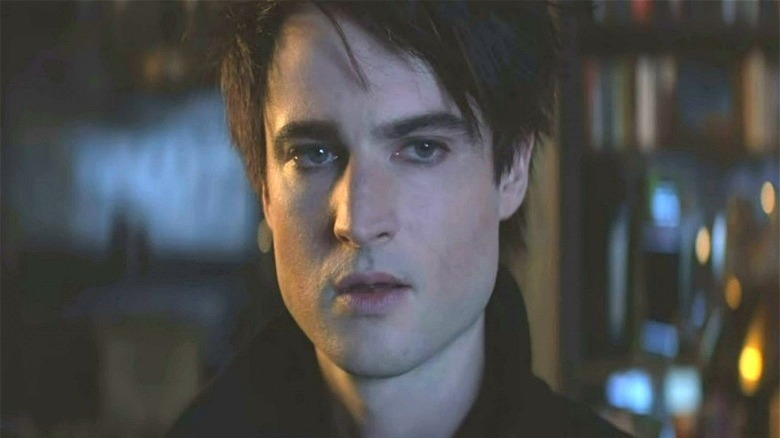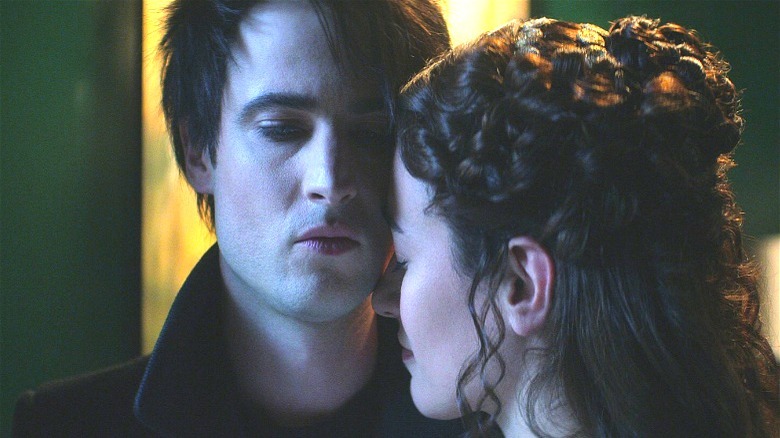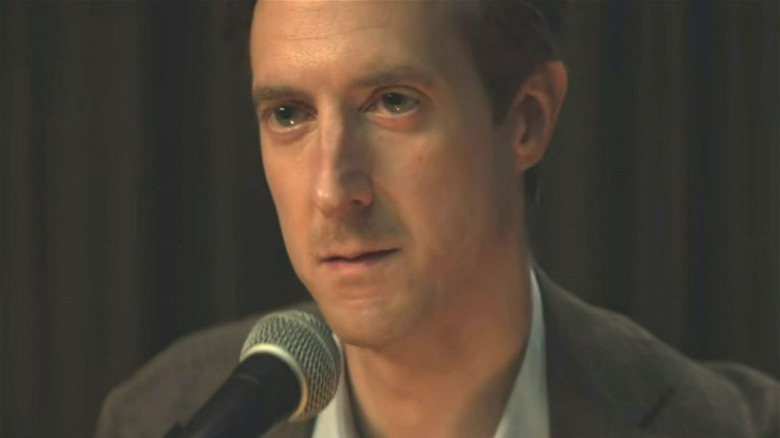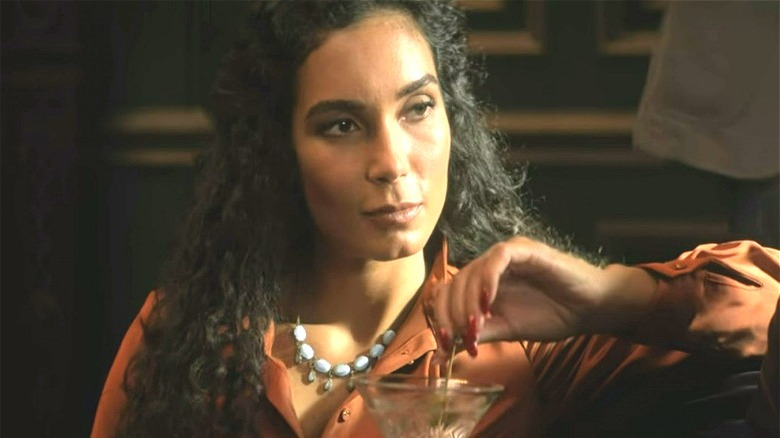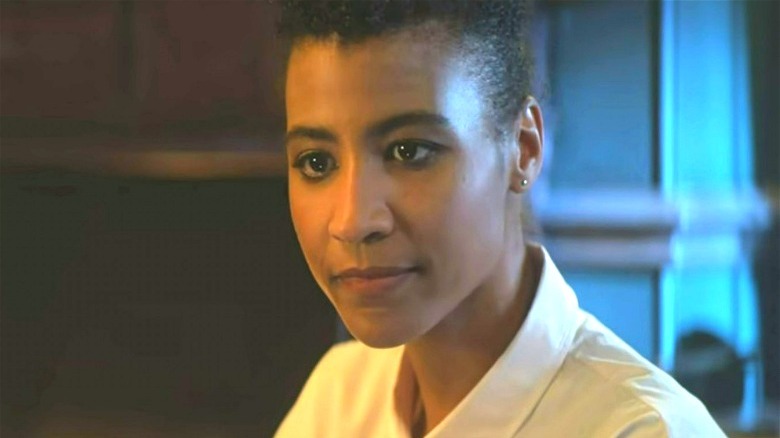Small Details You Missed In The Sandman Bonus Episode
The 10-episode first season of "The Sandman" premiered on Netflix on August 5, 2022, chronicling the imprisonment of Dream (Tom Sturridge) by the occultist Roderick Burgess (Charles Dance), his eventual escape, and the rebuilding of his kingdom. The debut season features a number of interwoven plot lines, such as the murderous reign of escaped nightmare Corinthian (Boyd Holbrook) and the ambitions of Lucifer Morningstar (Gwendoline Christie). But, while some episodes feel more like independent vignettes, they all work together to tell a singular story of redemption, reconstruction, and change.
The 11th episode of "The Sandman" Season 1 is a bit different. Released on Netflix two weeks after the rest of the season, "Dream of a Thousand Cats/Calliope" adapts two different tales from Neil Gaiman's original DC comics in a single, extended episode. The first story, which diverts from the rest of the show by being fully animated, relays the journey of a cat prophet who preaches that all cats must dream in order to be free of humanity's cruelty. The second part of the episode, "Calliope," follows an author named Richard Madoc (Arthur Darvill) who imprisons and abuses the eponymous muse in search of fame. Ultimately, his vile deeds catch up to him in the form of Dream.
Something of an anomaly among streaming releases, "Dream of a Thousand Cats/Calliope" is ancillary, but it's also packed with details and hidden meaning. Here are some things in the "Sandman" bonus episode that you may have missed.
The reason some cats look different to others
"Dream of a Thousand Cats" looks a lot different to the rest of "The Sandman" thanks to its unique style of animation. The episode is directed by Hisko Hulsing, a Dutch animator who utilized a similar visual style in the Amazon Prime Video series "Undone." As in that show, "Dream of a Thousand Cats" blends multiple styles of animation and filmmaking to create the effect seen on screen.
"What we did was rotoscope all the cats," Hulsing explained in an interview with CBR. "First was the 3D cats. Then it was all being traced and painted, with all shading based on the 3D cats and stylized." These shaded 3D models were then superimposed over a series of oil painting backgrounds, similar to the ones used by the director on "Undone." The human characters seen in the episode were created by filming live actors on a soundstage, rotoscoping them, and adding on some of the same shading and styling touches seen on the cats.
The result of this complicated production process is quite striking, and it has some curious side effects. For instance, at different points in the episode, different cats seem to animate differently. Sometimes their movements are swift and fluid, revealing the underlying CGI, and sometimes they look more like stop-motion characters. It's certainly a distinct aesthetic, and it adds to the episode's ethereal vibe.
Don't F**k with Dreams
The following entry contains mentions of murder and the mistreatment of animals.
For ardent Netflix subscribers, "Dream of a Thousand Cats" may conjure memories of another recent hit on the streamer — the three-part true crime documentary series "Don't F**k with Cats." The documentary centers on the murder of Jun Lin, a student at Montreal's Concordia University, at the hands of Canadian adult film actor Luka Magnotta. Magnotta had been the subject of some internet investigations prior to the murder, mostly due to a video of him suffocating two kittens in a vacuum bag. The documentary sparked conversation about the broader implications of hating cats — something "The Psychopath Test" author Jon Ronson has said may be indicative of psychopathy.
In "Dream of a Thousand Cats," the prophet cat relays a tragic backstory of having her own children taken from her and killed by her owner, who put them in a bag weighed down with bricks and drowned them. This is the event that causes her to strike out on her own and venture to the Dreaming, leading to a potential cat revolution. Whether intentional or not, the scene certainly evokes the earlier Netflix documentary, and the episode's alternate reality where massive cats hunt humans should be a healthy reminder to treat your pets — and all animals — with respect.
In actuality, Gaiman's story precedes both the Netflix documentary and the crime it chronicles. "Dream of a Thousand Cats" was first published as "The Sandman" Volume 2 #18 in 1990, and the story is basically unchanged in the Netflix version.
A touching tombstone
One touching detail in "Dream of a Thousand Cats" that nearly every viewer will miss involves a particular tombstone in the graveyard where the cats gather. As the kitten and the gray cat enter the cemetery and join the throng of cats gathered to hear the prophet speak, you can make out the inscription on one particular headstone behind them. "Frank Hulsing," the name on the gravestone reads, with the words "Hier ligt Frank, oorzaak drank" beneath it. This is a subtle homage to the real Frank Hulsing, father of the episode's director Hisko Hulsing.
Hulsing discussed the tribute to his father in an interview with Digital Spy. "He liked a drink or two and he devised his own epitaph: 'Here lies Frank — because he drank,'" the director explained. "I always regretted that we didn't grant my father's request." Hustling explained that when his father passed away, his family decided to go with a "more neutral epitaph," and that he asked both his mother and brother for permission to include his father's joke — in Dutch — in "The Sandman." While certainly not central to the story in any way, it's a touching detail for those in the know.
Familiar faces (and voices)
For a one-off bonus episode, "Dream of a Thousand Cats/Calliope" boasts an impressive cast. The first story of the two-parter features a star-studded vocal ensemble, with Sandra Oh ("Killing Eve") playing the prophet and Rosie Day ("Outlander") voicing the kitten. The supporting cast includes both David Tennant and Michael Sheen — the two co-stars of another Neil Gaiman adaptation, Amazon's "Good Omens." "X-Men" star James McAvoy also makes a cameo, which is fitting given that he plays Dream in the Audible audio adaptation of "The Sandman." Gaiman himself even contributes to the voice cast as the skeletal crow the prophet meets in the Dreaming. As a frequent narrator of his own books, it's no surprise that the author does an excellent and spooky job.
"Calliope" is also packed with stars, including "Doctor Who" alumni Arthur Darvill and Amita Suman, best known for her turn as Inej Ghafa in "Shadow and Bone." Guest star Derek Jacobi, who plays the villainous writer Erasmus Fry in "Calliope," also has a "Doctor Who" credit to his name, in addition to playing Metatron in Amazon's live-action "Good Omens" series alongside Tennant and Sheen.
Cat Dream shows he has no true form
Morpheus himself only makes a small appearance in "Dream of a Thousand Cats," despite being the main character of "The Sandman." And when he does show up, it's in a very different form than the one fans are used to seeing.
If you wanted to see what the Lord of Dreams would look like as a cat, your wish has been granted. Morpheus' feline form is definitely furry, but it's also pretty spooky, embodying the same shadowy energy as his human shape. Why does Dream appear to the prophet as a cat? It's not overtly explained in the episode, but those who've recently watched the rest of Season 1 may put the pieces together. During his journey to Hell earlier in the season, Dream encounters a former lover who's imprisoned there. When she looks upon him, the camera shows Dream as she sees him — a totally different man played by Ernest Kingsley Junior. Combined with the cat scene, this explains that Morpheus takes different forms — perhaps an infinite number — depending on who he's interacting with. During his time in prehistoric Africa, where his lover Nada ruled, Dream took on the look of a local, even adopting a different name, Kai'ckul.
The prophet even refers to Morpheus as the "Cat of Dreams," rather than the King of Dreams. Since he is dream incarnate, rather than simply someone who controls dreams, it makes sense that his form alters depending on who he's talking to.
A cat may look at a king
When the prophet cat meets Morpheus in "Dream of a Thousand Cats," he asks her why she's come. She replies that she wants answers — an explanation for why cats are forced to be subservient to humans. Apparently intrigued, Dream asks her to look into his eyes for a "revelation." "A cat may look at a king, or so they say," he tells her.
This stray line to a stray cat is an interesting choice of words. An old English expression that first appeared in print in the 16th century, it's generally taken as an adage that even seemingly common creatures have autonomy and can take part in supposedly great things. This principle is one of the main themes explored in "The Sandman" Season 1 — the belief that every life has a significance to it, which is manifested in some ways through dreams.
It's also curious that Morpheus chooses to quote a human proverb to the cat who's come to see him. It's not a cat expression, after all, nor is it a saying of the Endless. This little detail of Dream quoting a human writer in passing speaks to his symbiotic relationship with humanity, as well as his affinity for well crafted words. After all, Dream is a writer himself.
Twisted mythologies
Most of Neil Gaiman's writing is a blending act of different mythologies and folktales, sprinkled with the author's own unique storytelling style. This is true in "The Sandman" as well, but the diversity of inspiration present in the series isn't really visible until "Calliope." The titular character of the tale is a muse of Greek myth, a subject of several ancient tales. She calls herself a daughter of Zeus, confirming the existence of the Greek Pantheon in the "Sandman" universe, and she also invokes the Romans and Hell. This intertwining of different mythologies and religions into a single character is quite interesting, and it expands the world of "The Sandman" as shown in the rest of Season 1.
Of course, just because these mythic inspirations are present in the series doesn't mean that they're exactly what you'd expect. When Calliope calls upon the three Fates, also known as the Furies, or the Kindly Ones, they tell her that "many gods have died," and that "only the Endless never fade." Though Dream claims in the series to be much weaker than some other god-like characters, like Lucifer Morningstar, he clearly possesses a unique permanence shared only by his siblings.
Dream's many names
Morpheus goes by many different names in "The Sandman" Season 1, and "Dream of a Thousand Cats/Calliope" adds several more to the long list. The prophet refers to him as the "Cat of Dreams," and he indeed takes a feline form when speaking with her. Later on in "Calliope," the eponymous muse gives Morpheus several previously unheard names. She tells Madoc that the Romans called him the "Shaper of Forms." She herself, as a part of the ancient Greek mythos, refers to Morpheus as Oneiros — the name for dreams personified in Greek myth.
This is particularly interesting because of another detail mentioned about Calliope — that she was once the muse of Homer, the writer of "The Iliad" and "The Odyssey." One of the most notable instances of personified dreams in Greek myth occurs in "The Iliad" when Zeus — Calliope's father — sends one to Agamemnon. Similar references to personified dreams also occur in "The Odyssey." This could be meant as a subtle reference to Dream and Calliope's relationship as told through one of her writers, though there's nothing to officially confirm that.
Morpheus and Orpheus
When Calliope prays to the Fates for deliverance from her imprisonment, they suggest she reach out to Dream for help, as the two have a history together. When Morpheus eventually comes to help her after escaping his own confinement, it's revealed just how complicated that history is.
In "The Sandman," as in several versions of the ancient Greek myth, Calliope is the mother of Orpheus, a musician of divine talent. The singer's father, as you might guess from the name, is Morpheus. During their interaction in the episode, Dream and Calliope allude to a tragedy involving their son that ultimately drove them apart. If you're well versed in Greek mythology, you likely already know most of the story.
Orpheus is most famous for the tale of him and his lover Eurydice, for whom he travels into the bowels of the underworld to try to resurrect to life. Simply put, their escape attempt ends poorly, and Eurydice is trapped in the realm of the dead forever, leaving Orpheus to mourn. This all happens in the "Sandman" comics as well, where Orpheus' sorrow eventually leads to him losing all physical form but his head (in pretty gruesome fashion). It seems that the Netflix series has changed some details from the comics, as Calliope and Dream speak of their son as if he were dead, not simply disembodied. Calliope also references him going to "Hell," rather than "Hades," the Greek underworld where Orpheus travels to in the comics.
The Cabaret of Dr. Caligari
Before resorting to the jailing and abuse of a muse in "Calliope," Richard Madoc has only written one book — a novel called "The Cabaret of Dr. Caligari." One scene shows him scrolling through his Instagram and subreddit pages online, looking at fan theories about his upcoming work. "The Cabaret of Dr. Caligari" is also the name of the novel Madoc writes in the original DC comics, but the title has another meaning for fans of 1990s British radio plays.
"The Cabaret of Dr. Caligari" is also the name of a series of BBC Radio 4 comedy plays, which originally aired in 1991. Set in a nightclub owned by the titular character, the radio play featured a number of zany characters dealing with fantastical and surreal circumstances. While Gaiman's comics precede the BBC "Cabaret," both may be paying homage to a much older property — the 1920 German film "The Cabinet of Dr. Caligari."
The movie, now over a century old, has a couple of details that relate to the story of "Calliope." The plot involves both a sleepwalking murderer — strikingly relevant to a story about dreams — and the cycles of violence perpetuated by corrupt, powerful men. Just as Madoc continues Erasmus Fry's cruelty toward Calliope, so too does the villainous Dr. Caligari try to emulate the crimes of an older killer.
Writers are liars
Writers are liars. It's a phrase said multiple times in the "Sandman" bonus episode, and one with multiple meanings. At face value, it sounds more innocuous than villainous. Sure, writers lie. Stories are, more often than not, less than the whole truth, especially in the realm of fiction. That's part of their power, though, and "The Sandman" is, at its core, a story about the power of stories.
But as we watch Richard Madoc and Erasmus Fry build their careers on abuse and greed, it becomes clear that writers can be liars in far more vile ways. Madoc in particular is a golden case study in performative allyship — a man who cultivates a reputation of equity and inclusivity in his work despite having a woman locked in his attic. There are a bunch of nods to this farce of progressivism throughout the episode, such as Madoc describing himself as a feminist writer at a party, and his demand during a phone conversation that the crew of an upcoming adaptation of his work be "50% women and people of color." During an interview conducted at his home, Madoc is asked who his main literary influences were growing up, and he cites three female authors — Shirley Jackson, Margaret Atwood, and Octavia E. Butler.
It may well be that Madoc truly believes himself to be an altruistic, progressive writer, but his actions at home clearly belie that façade. In "Calliope," writers lie often — even to themselves.
Meta commentary
Much of "The Sandman" Season 1 is about storytelling, as Dream himself is a spinner of subconscious yarns, but "Calliope" puts that theme front and center. By telling a tale of an author's quest for fame and fortune, Gaiman and the other writers are able to include some winks and nods to the quirks of the publishing industry. For instance, in one scene, two critics can be heard talking at a party about Madoc's new book being up for an award. "I will never understand how a work of genre fiction came to be nominated, let alone shortlisted," one of the men says. "The committee felt Madoc's new book has transcended genre," the other replies. That particular description has been used many times over the years to reference "The Sandman" itself, so it's likely that this is an instance of Gaiman poking a bit of fun at the discourse that's always surrounded his work.
In fact, the exchange is strikingly similar to a real-life encounter Gaiman had at a Christmas party in 1989. "I got talking to somebody who, if memory serves, was literary editor at the Telegraph," the writer told The Guardian in 2022. "They asked what I did, and I said I wrote comics. The gentleman looked as though I'd slapped him with a herring." Once Gaiman explained who he was, however, the editor's tone changed. "He said: 'Oh my dear fellow, you don't write comics, you write graphic novels!'" Gaiman clearly finds the common literary distaste for fantasy a bit bizarre, and that's reflected in the dialogue in "Calliope."
